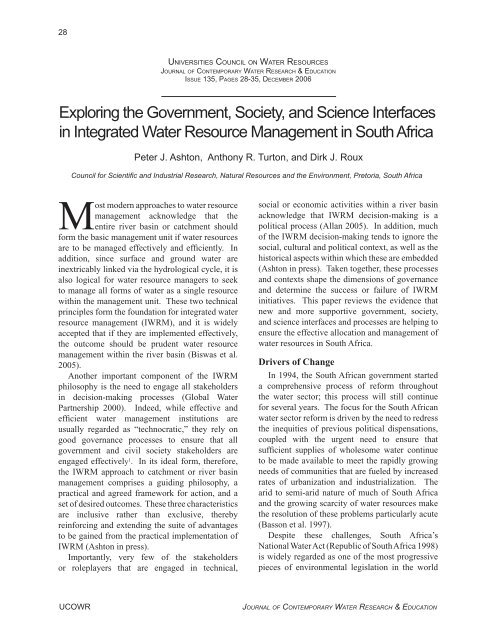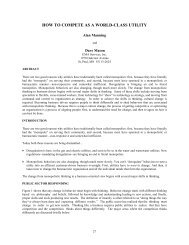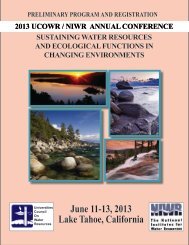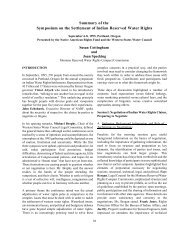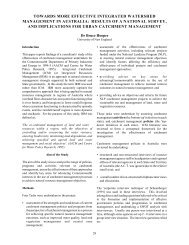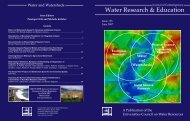Full Journal of Contemporary Water Research and Education, Issue ...
Full Journal of Contemporary Water Research and Education, Issue ...
Full Journal of Contemporary Water Research and Education, Issue ...
Create successful ePaper yourself
Turn your PDF publications into a flip-book with our unique Google optimized e-Paper software.
28UNIVERSITIES COUNCIL ON WATER RESOURCESJOURNAL OF CONTEMPORARY WATER RESEARCH & EDUCATIONISSUE 135, PAGES 28-35, DECEMBER 2006Exploring the Government, Society, <strong>and</strong> Science Interfacesin Integrated <strong>Water</strong> Resource Management in South AfricaPeter J. Ashton, Anthony R. Turton, <strong>and</strong> Dirk J. RouxCouncil for Scientifi c <strong>and</strong> Industrial <strong>Research</strong>, Natural Resources <strong>and</strong> the Environment, Pretoria, South AfricaMost modern approaches to water resourcemanagement acknowledge that theentire river basin or catchment shouldform the basic management unit if water resourcesare to be managed effectively <strong>and</strong> efficiently. Inaddition, since surface <strong>and</strong> ground water areinextricably linked via the hydrological cycle, it isalso logical for water resource managers to seekto manage all forms <strong>of</strong> water as a single resourcewithin the management unit. These two technicalprinciples form the foundation for integrated waterresource management (IWRM), <strong>and</strong> it is widelyaccepted that if they are implemented effectively,the outcome should be prudent water resourcemanagement within the river basin (Biswas et al.2005).Another important component <strong>of</strong> the IWRMphilosophy is the need to engage all stakeholdersin decision-making processes (Global <strong>Water</strong>Partnership 2000). Indeed, while effective <strong>and</strong>efficient water management institutions areusually regarded as “technocratic,” they rely ongood governance processes to ensure that allgovernment <strong>and</strong> civil society stakeholders areengaged effectively 1 . In its ideal form, therefore,the IWRM approach to catchment or river basinmanagement comprises a guiding philosophy, apractical <strong>and</strong> agreed framework for action, <strong>and</strong> aset <strong>of</strong> desired outcomes. These three characteristicsare inclusive rather than exclusive, therebyreinforcing <strong>and</strong> extending the suite <strong>of</strong> advantagesto be gained from the practical implementation <strong>of</strong>IWRM (Ashton in press).Importantly, very few <strong>of</strong> the stakeholdersor roleplayers that are engaged in technical,social or economic activities within a river basinacknowledge that IWRM decision-making is apolitical process (Allan 2005). In addition, much<strong>of</strong> the IWRM decision-making tends to ignore thesocial, cultural <strong>and</strong> political context, as well as thehistorical aspects within which these are embedded(Ashton in press). Taken together, these processes<strong>and</strong> contexts shape the dimensions <strong>of</strong> governance<strong>and</strong> determine the success or failure <strong>of</strong> IWRMinitiatives. This paper reviews the evidence thatnew <strong>and</strong> more supportive government, society,<strong>and</strong> science interfaces <strong>and</strong> processes are helping toensure the effective allocation <strong>and</strong> management <strong>of</strong>water resources in South Africa.Drivers <strong>of</strong> ChangeIn 1994, the South African government starteda comprehensive process <strong>of</strong> reform throughoutthe water sector; this process will still continuefor several years. The focus for the South Africanwater sector reform is driven by the need to redressthe inequities <strong>of</strong> previous political dispensations,coupled with the urgent need to ensure thatsufficient supplies <strong>of</strong> wholesome water continueto be made available to meet the rapidly growingneeds <strong>of</strong> communities that are fueled by increasedrates <strong>of</strong> urbanization <strong>and</strong> industrialization. Thearid to semi-arid nature <strong>of</strong> much <strong>of</strong> South Africa<strong>and</strong> the growing scarcity <strong>of</strong> water resources makethe resolution <strong>of</strong> these problems particularly acute(Basson et al. 1997).Despite these challenges, South Africa’sNational <strong>Water</strong> Act (Republic <strong>of</strong> South Africa 1998)is widely regarded as one <strong>of</strong> the most progressivepieces <strong>of</strong> environmental legislation in the worldUCOWRJOURNAL OF CONTEMPORARY WATER RESEARCH & EDUCATION


